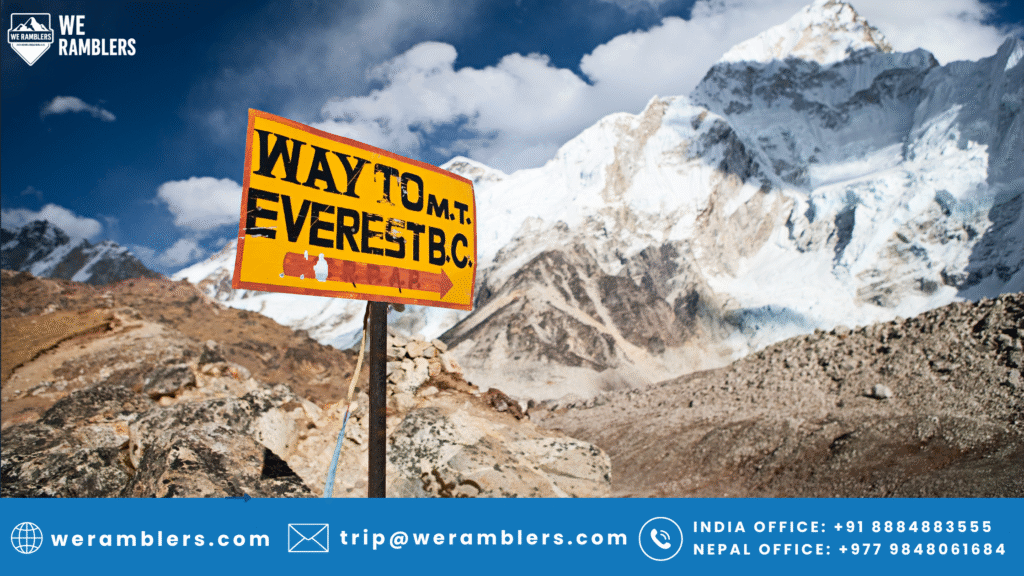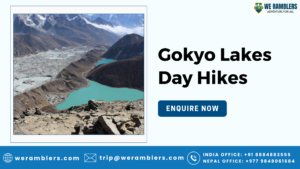How to Prepare for Everest Base Camp Trek – The Ultimate Guide
The Everest Base Camp Trek is more than just a hike; it’s a once-in-a-lifetime journey to the foot of the world’s highest mountain, Mount Everest (8,848.86 m). Every year, thousands of trekkers take on this challenge to experience breathtaking Himalayan landscapes, unique Sherpa culture, and the thrill of standing where mountaineers begin their summit attempt. But make no mistake; this is a demanding adventure that requires careful planning. If you’ve been wondering “How to Prepare for Everest Base Camp Trek”, you’ve come to the right place.
From physical training to packing the right gear, arranging trekking permits, and planning for altitude acclimatization, there’s a lot to consider before you set foot in the Khumbu region of Nepal. This detailed guide from We Ramblers will walk you through every step of Everest Base Camp Trek preparation so you can start your Himalayan journey fully prepared.
Understanding the Everest Base Camp Trek
The Everest Base Camp Trek is located in the spectacular Sagarmatha National Park, a UNESCO World Heritage Site in eastern Nepal’s Khumbu region. The round trip is approximately 130 kilometers (80 miles) and usually takes 12–14 days depending on your itinerary.
Major highlights include:
- Lukla (Tenzing-Hillary Airport) – your gateway to the trek.
- Namche Bazaar – the Sherpa capital and main acclimatization stop.
- Tengboche Monastery – the largest monastery in the Khumbu region.
- Dingboche and Pheriche – high-altitude Sherpa villages.
- Gorakshep – the last settlement before Base Camp.
- Kala Patthar – a viewpoint offering panoramic views of Everest, Lhotse, and Nuptse.
The trek involves significant altitude gain, reaching 5,364 meters at Base Camp and 5,545 meters at Kala Patthar. That’s why altitude acclimatization and proper physical preparation are crucial. Along the way, you’ll pass through rhododendron forests, suspension bridges, glacial rivers like the Dudh Koshi, and vibrant Sherpa communities.
Physical & Mental Preparation for Everest Base Camp Trek
1. Build Cardiovascular Endurance
Cardio training is essential to handle the steep ascents and long walking hours. Focus on:
- Running or jogging (3–4 times a week)
- Cycling or swimming for low-impact endurance
- Hiking on varied terrain
2. Strength Training
Your legs, core, and upper body need to be strong to handle daily 5–7 hour treks while carrying a backpack. Include:
- Squats, lunges, and step-ups for leg strength
- Planks and core exercises for balance
- Push-ups and shoulder presses for upper body endurance
3. Practice with a Backpack
Train with a loaded backpack (5–8 kg) to simulate actual trekking conditions.
4. Mental Preparation
Trekking to Everest Base Camp is as much a mental challenge as a physical one. Long days, unpredictable weather, and high altitude require resilience. Visualization techniques, positive self-talk, and realistic expectations can help you stay motivated.
Packing List for Everest Base Camp Trek
Having the right trekking gear is vital for comfort and safety. Here’s your essential Everest Base Camp Trek packing list:
Clothing Layers
- Base layer (moisture-wicking thermal top & bottom)
- Mid layer (fleece jacket or light down jacket)
- Outer layer (waterproof and windproof jacket & trousers)
- Trekking pants & quick-dry T-shirts
- Insulated down jacket for high altitudes
Footwear & Accessories
- Waterproof trekking boots (well broken-in)
- Merino wool socks (3–4 pairs)
- Trekking poles for knee support
- Warm gloves, beanie, and sun hat
- Sunglasses with UV protection
Sleeping Gear
- Sleeping bag rated for -10°C to -15°C
- Sleeping bag liner for added warmth
Other Essentials
- Headlamp with spare batteries
- Reusable water bottles or hydration bladder
- Water purification tablets or filter
- First aid kit with blister treatment & medications
- Sunscreen & lip balm with SPF
- Snacks like energy bars & nuts
Documents & Permits
- Passport (with Nepal visa)
- Sagarmatha National Park Permit
- Khumbu Pasang Lhamu Rural Municipality Permit

Acclimatization & Altitude Sickness Prevention During Everest Base Camp Trek
Acute Mountain Sickness (AMS) is one of the main risks on the trek. Symptoms include headache, nausea, fatigue, and dizziness.
Prevention tips:
- Acclimatization days at Namche Bazaar and Dingboche are essential.
- Walk at a slow, steady pace — “climb high, sleep low.”
- Stay well-hydrated (3–4 liters per day).
- Avoid alcohol and smoking.
- Eat balanced, high-energy meals.
A certified guide will monitor your health and ensure you follow safe ascent practices. If symptoms worsen, descending is the only cure.
Best Time for Everest Base Camp Trek
The two best seasons for the trek are:
- Spring (March–May) – Clear skies, blooming rhododendrons, warmer daytime temperatures.
- Autumn (September–November) – Stable weather, excellent mountain visibility, peak trekking season.
Winter (Dec–Feb) can be extremely cold with heavy snow at higher altitudes, while monsoon (June–August) brings rain, slippery trails, and lower visibility.
Permits, Flights & Logistics for Everest Base Camp Trek
Permits Required
1. Sagarmatha National Park Entry Permit
2. Khumbu Pasang Lhamu Rural Municipality Permit
These can be arranged in Kathmandu or via We Ramblers as part of your trek package.
Flight to Lukla
Most treks start with a short but thrilling flight from Ramechhap (Manthali) or Kathmandu to Lukla. Due to weather conditions, flight delays are common, so plan buffer days in your itinerary.
Local Regulations
As per the 2023 rule, all trekkers must be accompanied by a certified guide for safety and navigation in high-altitude regions.
We Ramblers — Your Trusted Partner for EBC Trekking
At We Ramblers, we specialize in organizing unforgettable trekking experiences across Nepal, Bhutan, and India. With a team of highly experienced and certified guides, we focus on safety, sustainability, and authentic cultural immersion.
Our Everest Base Camp Trek itineraries are designed to include proper acclimatization days, comfortable teahouse stays, and opportunities to explore iconic places like Namche Bazaar, Tengboche Monastery, and Kala Patthar. We provide detailed pre-trek guidance, high-quality equipment recommendations, and personalized support so you can focus on enjoying the trek of a lifetime.
Frequently Asked Questions (FAQs) on How to Prepare for Everest Base Camp Trek
Q1: How long should I train for Everest Base Camp Trek?
A minimum of 8–12 weeks of physical preparation, including cardio, strength, and endurance training, is recommended.
Q2: Can beginners do Everest Base Camp Trek?
Yes, with good fitness, proper acclimatization, and guidance from a certified trekking guide, beginners can complete the trek.
Q3: How much does it cost to prepare for Everest Base Camp Trek?
Preparation costs vary depending on gear purchases, training expenses, and insurance. Trek packages with We Ramblers start at competitive rates.
Q4: What is the most important gear for EBC Trek?
Sturdy trekking boots, layered clothing, and a good-quality sleeping bag are crucial for comfort and safety.
Q5: How do I avoid altitude sickness during the trek?
Take acclimatization days, maintain a slow pace, stay hydrated, and follow your guide’s instructions.





